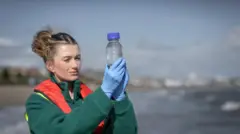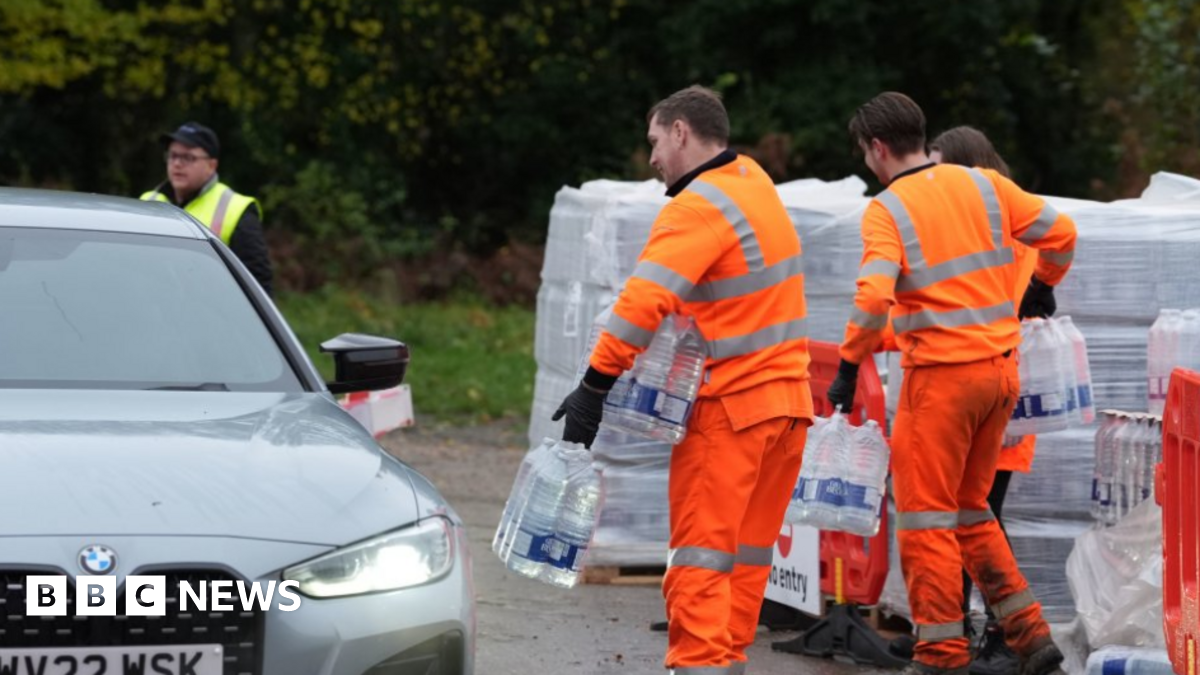Firms ordered to reduce forever chemicals in drinking water for 6m people – BBC

Report on Per- and Polyfluoroalkyl Substances (PFAS) Contamination in UK Drinking Water and Implications for Sustainable Development Goals
Executive Summary
An investigation reveals that water companies have been issued enforcement notices concerning potentially harmful levels of Per- and Polyfluoroalkyl Substances (PFAS), or “forever chemicals,” in drinking water sources supplying over six million people. This situation presents significant challenges to the achievement of several United Nations Sustainable Development Goals (SDGs), particularly SDG 3 (Good Health and Well-being), SDG 6 (Clean Water and Sanitation), and SDG 12 (Responsible Consumption and Production). The persistent nature of these pollutants, coupled with regulatory and technological challenges, necessitates a comprehensive strategy that aligns with the 2030 Agenda for Sustainable Development.
Analysis of Contamination and Public Health Risks (SDG 3 & SDG 6)
The presence of PFAS in drinking water sources poses a direct threat to public health and water quality, undermining progress towards key SDG targets.
- Scope of Contamination: Enforcement notices from the Drinking Water Inspectorate (DWI) have been issued for water supply systems serving a minimum of six million people due to elevated PFAS levels, which could “constitute a potential danger to human health.” This directly impacts SDG Target 6.1, which aims for universal access to safe drinking water.
- Health Implications: The World Health Organization has classified specific PFAS compounds, PFOA and PFOS, as carcinogenic and possibly carcinogenic, respectively. The detection of these banned substances in over 350 drinking water tests in 2024 highlights a significant risk to public health, conflicting with the core objective of SDG 3 to ensure healthy lives and promote well-being.
- Monitoring Data: Since 2021, water companies have conducted 1.7 million tests for PFAS. Of these, at least 9,432 recorded levels above the DWI’s guidance threshold of 0.01 micrograms per litre, indicating a widespread challenge in maintaining water quality as stipulated by SDG Target 6.3 (improve water quality by reducing pollution).
Production, Pollution, and Environmental Impact (SDG 12, SDG 14, SDG 15)
The contamination is a direct result of unsustainable production and consumption patterns, which have led to the widespread environmental release of these persistent chemicals.
- Sources of Pollution: PFAS enter water systems through industrial releases, storm runoff, and leaching from landfill sites and firefighting training areas. This reflects a failure in the environmentally sound management of chemicals and wastes, a key component of SDG Target 12.4.
- Chemical Persistence: The chemical structure of PFAS prevents them from breaking down easily, leading to their accumulation in the environment. This bioaccumulation threatens aquatic and terrestrial ecosystems, impacting SDG 14 (Life Below Water) and SDG 15 (Life on Land).
- Call for Producer Responsibility: Industry body Water UK has advocated for a ban on PFAS and the implementation of a “polluter pays” principle, where manufacturers are held financially responsible for environmental remediation. This aligns with SDG 12’s goal of encouraging companies to adopt sustainable practices.
Regulatory Framework and Technological Challenges (SDG 9 & SDG 16)
Addressing the PFAS crisis requires strengthening institutional frameworks and investing in innovative infrastructure, which are central to SDG 16 (Peace, Justice and Strong Institutions) and SDG 9 (Industry, Innovation, and Infrastructure).
- Regulatory Gaps: Concerns have been raised by the Royal Society of Chemistry and environmental charities that current UK guidelines are not legally binding and are less stringent than international standards, such as those in the US. This points to a need for more effective and accountable institutions (SDG 16) to protect public health.
- Treatment and Infrastructure: While the DWI requires water companies to take corrective action, removing PFAS with conventional water treatment infrastructure is difficult and costly. Advanced technologies like nanofiltration are effective but demand significant financial investment and energy, posing a challenge to the development of resilient and sustainable infrastructure under SDG 9.
- Government Response: An independent review commissioned by the government concluded that stricter treatment requirements are needed. A forthcoming government white paper is expected to propose changes to the DWI, indicating a potential move towards a stronger regulatory environment in line with SDG principles.
Analysis of Sustainable Development Goals in the Article
1. Which SDGs are addressed or connected to the issues highlighted in the article?
- SDG 3: Good Health and Well-being: The article directly links the presence of “forever chemicals” (PFAS) in drinking water to significant human health risks, including an increased risk of thyroid, testicular, and kidney cancers. The World Health Organization’s classification of PFOA as carcinogenic and PFOS as possibly carcinogenic underscores this connection.
- SDG 6: Clean Water and Sanitation: The core theme of the article is the contamination of drinking water sources with hazardous chemicals. It discusses the quality of water supplied to millions of people, the need for treatment, and the enforcement actions taken to ensure water safety, all of which are central to SDG 6.
- SDG 12: Responsible Consumption and Production: The article addresses the lifecycle of PFAS, from their use in “thousands of products from frying pans to medical equipment” to their release into the environment from industrial sites and consumer products. The call by Water UK to ban PFAS and hold manufacturers responsible for cleanup costs directly relates to achieving sustainable management and responsible production of chemicals.
- SDG 15: Life on Land: The persistence of PFAS as pollutants that “build up in the environment” affects freshwater ecosystems. The article mentions contamination of water sources like aquifers and reservoirs, which are critical components of inland freshwater ecosystems protected under this goal.
2. What specific targets under those SDGs can be identified based on the article’s content?
-
Under SDG 3 (Good Health and Well-being):
- Target 3.9: By 2030, substantially reduce the number of deaths and illnesses from hazardous chemicals and air, water and soil pollution and contamination. The article’s focus on PFAS, which are linked to “serious illnesses” and specific cancers (thyroid, testicular, kidney), directly aligns with this target of reducing illness from water pollution by hazardous chemicals.
-
Under SDG 6 (Clean Water and Sanitation):
- Target 6.1: By 2030, achieve universal and equitable access to safe and affordable drinking water for all. The article reveals that water sources for “more than six million people” have potentially harmful levels of PFAS, questioning the “safe” aspect of their drinking water and highlighting the challenge in achieving this target.
- Target 6.3: By 2030, improve water quality by reducing pollution, eliminating dumping and minimizing release of hazardous chemicals and materials. The article details how PFAS enter water sources through “storm runoff and releases from industrial sites,” and it discusses the need for water companies to treat the water to remove these hazardous chemicals, which is the essence of this target.
-
Under SDG 12 (Responsible Consumption and Production):
- Target 12.4: By 2020, achieve the environmentally sound management of chemicals and all wastes throughout their life cycle… and significantly reduce their release to air, water and soil in order to minimize their adverse impacts on human health and the environment. The article’s entire premise is about the adverse impact of PFAS on human health and the environment due to their release into water. The call to ban these chemicals and make manufacturers pay for removal directly supports the goal of sound chemical management.
3. Are there any indicators mentioned or implied in the article that can be used to measure progress towards the identified targets?
-
For Targets 3.9, 6.3, and 12.4:
- Concentration of PFAS in drinking water: The article explicitly mentions the regulatory threshold used by the Drinking Water Inspectorate (DWI): “0.01ug/L – (micrograms per litre)”. Measuring the levels of specific chemicals like PFOS and PFOA in water is a direct indicator of pollution and potential health risk.
- Frequency of exceeding safety limits: The article provides data on this, stating that out of 1.7 million tests, “at least 9,432 of those recorded PFAS levels above the level which the DWI says could constitute a potential danger to human health.” Tracking the number and percentage of tests that fail to meet standards is a clear indicator of water quality.
-
For Target 6.1:
- Population affected by contaminated water sources: The article quantifies the number of people whose drinking water sources are under enforcement notices for elevated PFAS levels as “a minimum of six million people.” This serves as an indicator of the population lacking access to verifiably safe drinking water.
4. Table of SDGs, Targets, and Indicators
| SDGs | Targets | Indicators |
|---|---|---|
| SDG 3: Good Health and Well-being | Target 3.9: Substantially reduce illnesses from hazardous chemicals and water pollution. |
|
| SDG 6: Clean Water and Sanitation | Target 6.1: Achieve universal access to safe drinking water. |
|
| Target 6.3: Improve water quality by reducing pollution and minimizing the release of hazardous chemicals. |
|
|
| SDG 12: Responsible Consumption and Production | Target 12.4: Achieve environmentally sound management of chemicals to reduce their release to water and soil. |
|
Source: bbc.com
What is Your Reaction?
 Like
0
Like
0
 Dislike
0
Dislike
0
 Love
0
Love
0
 Funny
0
Funny
0
 Angry
0
Angry
0
 Sad
0
Sad
0
 Wow
0
Wow
0




















































.jpg.webp?itok=0ZsAnae9#)


























